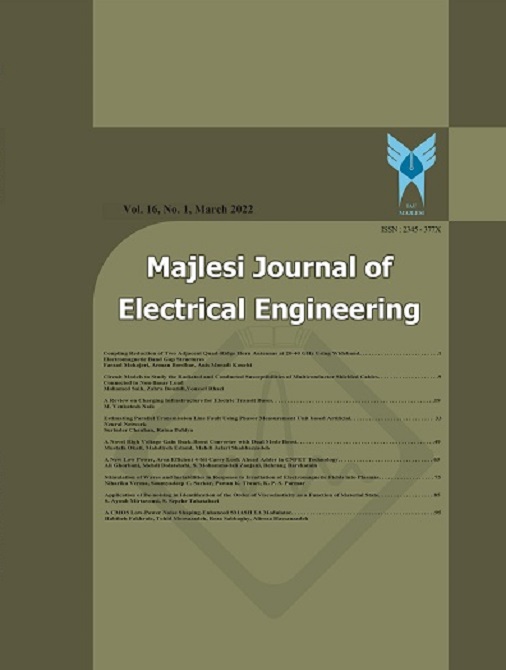[1] W.T. Thomson, “A review of on-line condition monitoring techniques for three-phase squirrel-cage induction motors –past, present and future,” in Proc. IEEE Int. Symp. SDEMPED 1, pp. 3–18, 1999.
[2] A. Ebadi, M. Mirzaie, and S. A. Gholamian, “Investigation of the effects of unbalanced voltages on the performance of a three-phase squirrel cage induction motor using finite element method,” Majlesi Journal of Electrical Engineering, 7(2), pp. 76-82. 2013.
[3] N. Bessous, S. E. Zouzou, S. Sbaa, and W. Bentrah, “A comparative study between the mcsa, dwt and the vibration analysis methods to diagnose the dynamic eccentricity fault in induction motors,” in Systems and Control Conference (ICSC), IEEE, pp. 414-421, 2017.
[4] A. M. Júnior, V. V. Silva, L. M. Bacarini, and L. F. Mendes, “The design of multiple linear regression models using a genetic algorithm to diagnose initial short-circuit faults in 3-phase induction motors,” Applied Soft Computing, pp. 50-58, 2018.
[5] G. Singh and V. N. A. Naikan , “Detection of half broken rotor bar fault in VFD driven induction motor drive using motor square current music analysis,” Mechanical Systems and Signal Processing, pp. 333-348, 2018.
[6] N. G. Lo, A. Soualhi, M. Frini, H. Razik, “Gear and bearings fault detection using motor current signature analysis,” in Industrial Electronics and Applications Conference, IEEE, 2018.
[7] N. Bessous, S. E. Zouzou, W. Bentrah, S. Sbaa, and M. Sahraoui, “Diagnosis of bearing defects in induction motors using discrete wavelet transform,” International Journal of System Assurance Engineering and Management, pp. 335-343, 2018.
[8] J. Martinez, A. Belahcen, and A. Muetze, “Analysis of the vibration magnitude of an induction motor with different numbers of broken bars,” IEEE transactions on industry applications, pp. 2711-2720, 2017.
[9] G. H. Bazan, P. R. Scalassara, W. Endo, A. Goedtel, W. F. Godoy, and R. H. C. Palacios, “Stator fault analysis of three-phase induction motors using information measures and artificial neural networks,” Electric Power Systems Research, pp. 347-356, 2017.
[10] A. Mejia-Barron, A., M. Valtierra-Rodriguez, D. Granados-Lieberman, J. C. Olivares-Galvan, and R. Escarela-Perez, “The Application of EMD-based methods for diagnosis of winding faults in a transformer using transient and steady state currents,” Measurement, pp. 371-379, 2018.
[11] N. Bessous, S. E. Zouzou, and A. Chemsa, “A new analytical model dedicated to diagnose the rolling bearing damage in induction motors-simulation and experimental investigation,” in Control Engineering and Information Technology Conference (CEIT), IEEE, pp. 1-9, 2016.
[12] M. Ojaghi, and R. Akhondi, “Modeling induction motors under mixed radial-axial asymmetry of the air gap produced by oil-whirl fault in a sleeve bearing”, IEEE Trans. Mag., 2018.
[13] C. Kumar, G. Krishnan, and S. Sarangi, “Experimental investigation on misalignment fault detection in induction motors using current and vibration signature analysis”, in Futuristic Trends on Computational Analysis and Knowledge Management IEEE, 61-66 2015.
[14] C. Wang, X. Bao, S. Xu, Y. Zhou, W. Xu, , and Y. Chen, “Analysis of vibration and noise for different skewed slot-type squirrel-cage induction motors”, IEEE Trans. Mag., pp. 1-6 2017.
[15] K. K. Nallamekala, “Harmonic cancellation technique of four pole induction motor drive by using phase shifted carrier space vector PWM technique,” Majlesi Journal of Electrical Engineering, 12(2), pp. 21-28, 2018.
[16] R. K. Patel, S. Agrawal, and N. C. Joshi, “Induction motor bearing fault identification using vibration measurement,” in Engineering and Systems (SCES), pp. 1-5, 2012.

